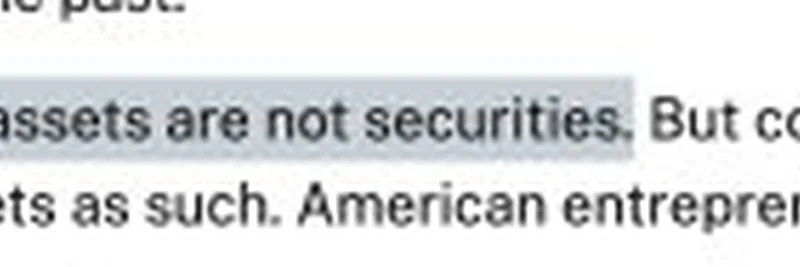Hey there, crypto enthusiasts! If you’ve been keeping an eye on the blockchain world, you’ve probably heard the buzz around a recent tweet from MartyParty (@martypartymusic) on July 31, 2025. This post dives into a game-changing statement from the SEC Chairman, suggesting that "most crypto assets are not securities." Let’s break it down and see what this means for the future of meme tokens and blockchain innovation—especially for those of us at Meme Insider who love digging into the latest trends!
What’s the Big Deal with the SEC’s Statement?
The tweet includes an image that sums it up nicely:
But here’s the catch: the confusion stems from the infamous Howey Test, a legal standard used to determine if an asset qualifies as an investment contract (and thus a security). The test checks if there’s an expectation of profit from the efforts of others—think of it like buying a stock where a company’s team drives the value. Some innovators have been playing it safe by treating all crypto assets as securities, just to avoid legal headaches.
How Does This Affect Meme Tokens and Blockchain?
So, what does this mean for meme tokens—those quirky, community-driven digital assets like Dogecoin or Shiba Inu? MartyParty’s thread suggests that open-source, decentralized Layer 1 blockchain tokens (the backbone of many networks) are more like commodities, not securities. Meme tokens, often born from internet culture, could fall into the "collectibles" category, which is a relief for creators and traders alike!
On the flip side, tokens tied to specific obligations—like Layer 2 sequencer tokens or wrapped assets (e.g., WBTC)—might still be treated as securities. This is because they involve counterparty risk or promises of returns, which the Howey Test flags. For meme token enthusiasts, this could mean more clarity on which projects need regulatory oversight and which can thrive in a decentralized wild west.
American entrepreneurs are already jumping on this, using blockchain tech to modernize industries. Imagine meme tokens powering decentralized apps or even charity drives—exciting times ahead!
The Road Ahead: Clarity or Just the Beginning?
MartyParty’s post also hints at a future where security tokens might need a registration process similar to traditional equity filings (think S-1 forms). This could streamline things for projects with clear investment contracts while leaving permissionless tokens—like many meme tokens—free to innovate.
The crypto community’s reaction on X is buzzing with optimism, with users like @0xJenWeb3 asking how this affects DeFi infrastructure built on wrapped assets. It’s a valid point—protocols might need to rethink their foundations. But for now, this feels like a step toward the regulatory clarity the industry has craved.
Why It Matters for You
If you’re a blockchain practitioner or a meme token fan, this SEC shift is a green light to explore new projects with less fear of overregulation. At Meme Insider, we’re excited to keep you updated with the latest news and insights. Stay tuned as we dive deeper into how this impacts the meme token ecosystem in 2025!
Got thoughts on this? Drop a comment below or join the conversation on our Discord community to share your take!



